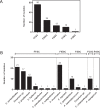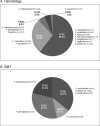Airborne transmission of invasive fusariosis in patients with hematologic malignancies
- PMID: 29698435
- PMCID: PMC5919535
- DOI: 10.1371/journal.pone.0196426
Airborne transmission of invasive fusariosis in patients with hematologic malignancies
Abstract
From 2006 to 2013, an increasing incidence of fusariosis was observed in the hematologic patients of our University Hospital. We suspected of an environmental source, and the indoor hospital air was investigated as a potential source of the fungemia. Air samplings were performed in the hematology and bone marrow transplant (BMT) wards using an air sampler with pre-defined air volumes. To study the molecular relationship among environmental and clinical isolates, 18 Fusarium spp. recovered from blood cultures were included in the study. DNA sequencing of a partial portion of TEF1α gene was performed for molecular identification. Molecular typing was carried out by multi-locus sequence typing (MLST) using a four-gene scheme: TEF1α, rDNA, RPB1 and RPB2. One hundred four isolates were recovered from the air of the hematology (n = 76) and the BMT (n = 28) wards. Fusarium isolates from the air were from five species complexes: Fusarium fujikuroi (FFSC, n = 56), Fusarium incarnatum-equiseti (FIESC, n = 24), Fusarium solani (FSSC, n = 13), Fusarium chlamydosporum (FCSC, n = 10), and Fusarium oxysporum (FOSC, n = 1). Fifteen Fusarium isolates recovered from blood belonged to FSSC, and three to FFSC. MLST identified the same sequence type (ST) in clinical and environmental isolates. ST1 was found in 5 isolates from blood and in 7 from the air, both identified as FSSC (Fusarium petroliphilum). STn1 was found in one isolate from blood and in one from the air, both identified as FFSC (Fusarium napiforme). F. napiforme was isolated from the air of the hospital room of the patient with fungemia due to F. napiforme. These findings suggested a possible clonal origin of the Fusarium spp. recovered from air and bloodcultures. In conclusion, our study found a diversity of Fusarium species in the air of our hospital, and a possible role of the air as source of systemic fusariosis in our immunocompromised patients.
Conflict of interest statement
Figures



References
-
- Zhang N, O'Donnell K, Sutton DA, Nalim FA, Summerbell RC, Padhye AA, et al. Members of the Fusarium solani species complex that cause infections in both humans and plants are common in the environment. J Clin Microbiol. 2006;44(6):2186–90. doi: 10.1128/JCM.00120-06 ; PubMed Central PMCID: PMCPMC1489407. - DOI - PMC - PubMed
-
- Chilaka CA, De Boevre M, Atanda OO, De Saeger S. The Status of Fusarium Mycotoxins in Sub-Saharan Africa: A Review of Emerging Trends and Post-Harvest Mitigation Strategies towards Food Control. Toxins (Basel). 2017;9(1). doi: 10.3390/toxins9010019 ; PubMed Central PMCID: PMCPMC5308251. - DOI - PMC - PubMed
-
- Nucci M, Anaissie E. Fusarium infections in immunocompromised patients. Clin Microbiol Rev. 2007;20(4):695–704. doi: 10.1128/CMR.00014-07 ; PubMed Central PMCID: PMCPMC2176050. - DOI - PMC - PubMed
-
- Muhammed M, Anagnostou T, Desalermos A, Kourkoumpetis TK, Carneiro HA, Glavis-Bloom J, et al. Fusarium infection: report of 26 cases and review of 97 cases from the literature. Medicine (Baltimore). 2013;92(6):305–16. doi: 10.1097/MD.0000000000000008 ; PubMed Central PMCID: PMCPMC4553992. - DOI - PMC - PubMed
-
- Guevara-Suarez M, Cano-Lira JF, de Garcia MC, Sopo L, De Bedout C, Cano LE, et al. Genotyping of Fusarium Isolates from Onychomycoses in Colombia: Detection of Two New Species Within the Fusarium solani Species Complex and In Vitro Antifungal Susceptibility Testing. Mycopathologia. 2016;181(3–4):165–74. doi: 10.1007/s11046-016-9983-9 . - DOI - PubMed
Publication types
MeSH terms
Substances
LinkOut - more resources
Full Text Sources
Other Literature Sources
Miscellaneous

